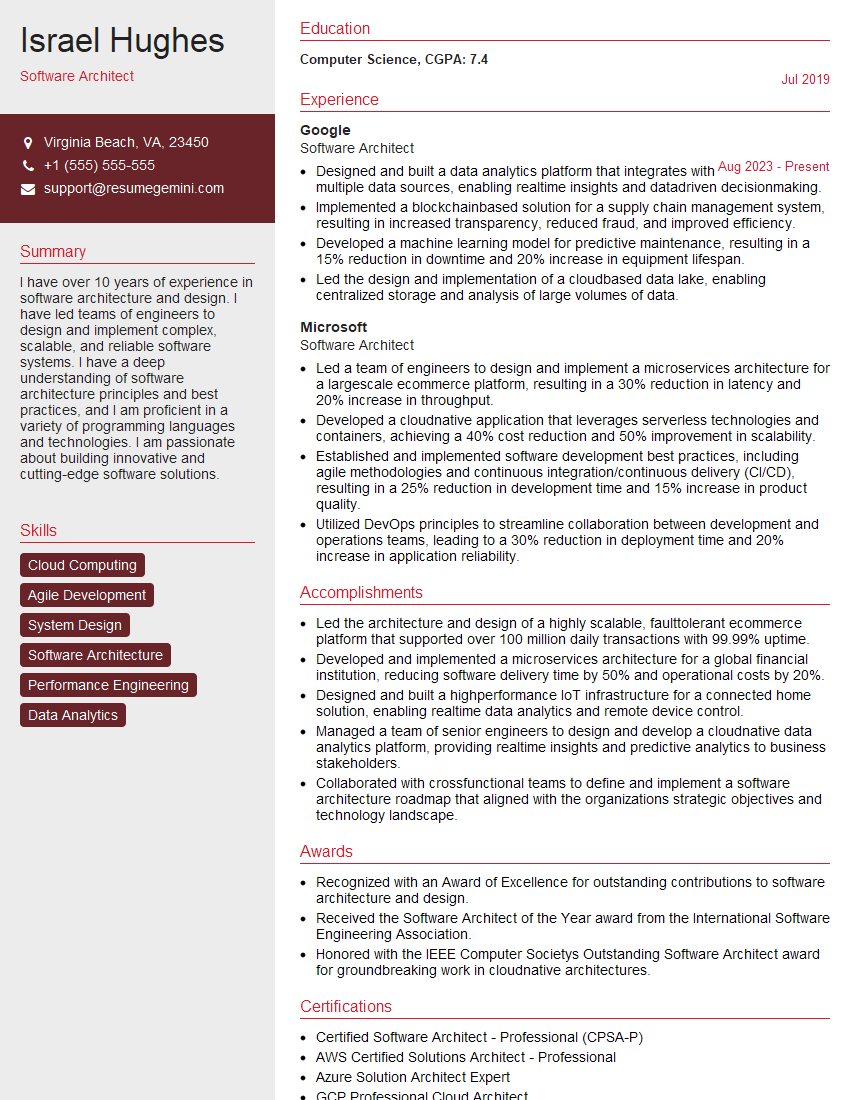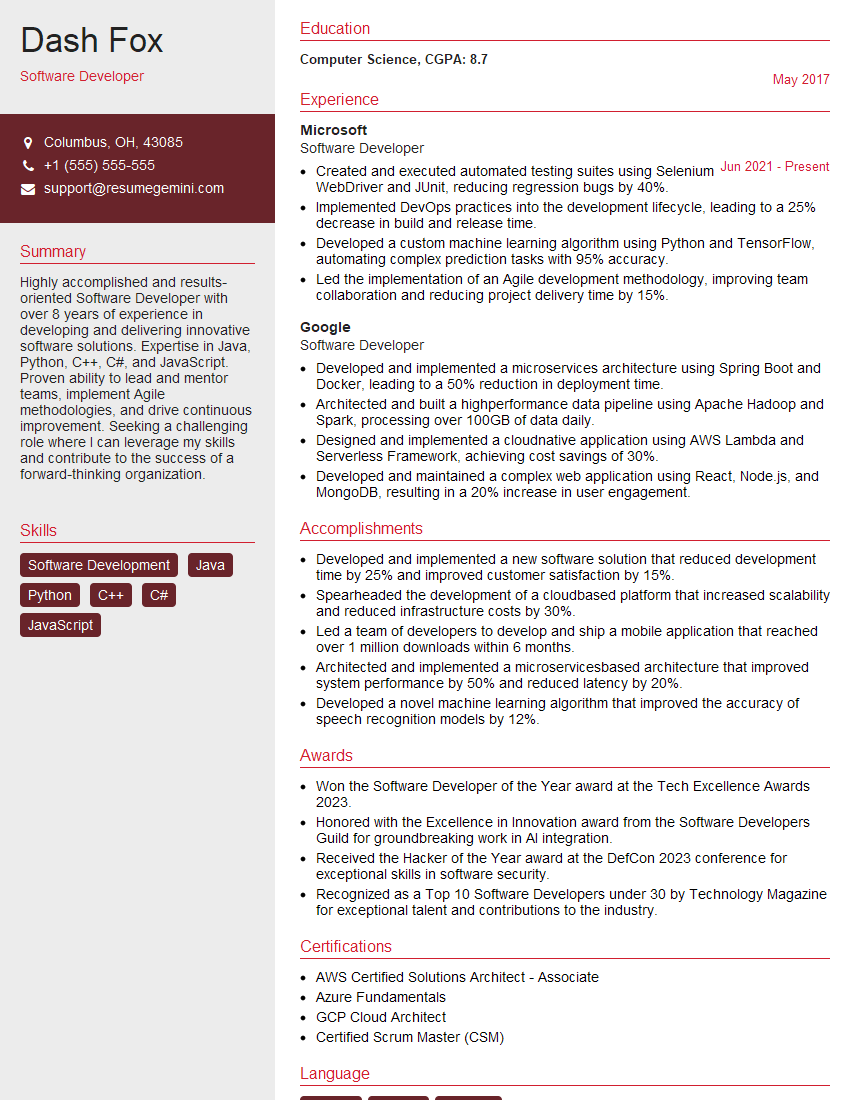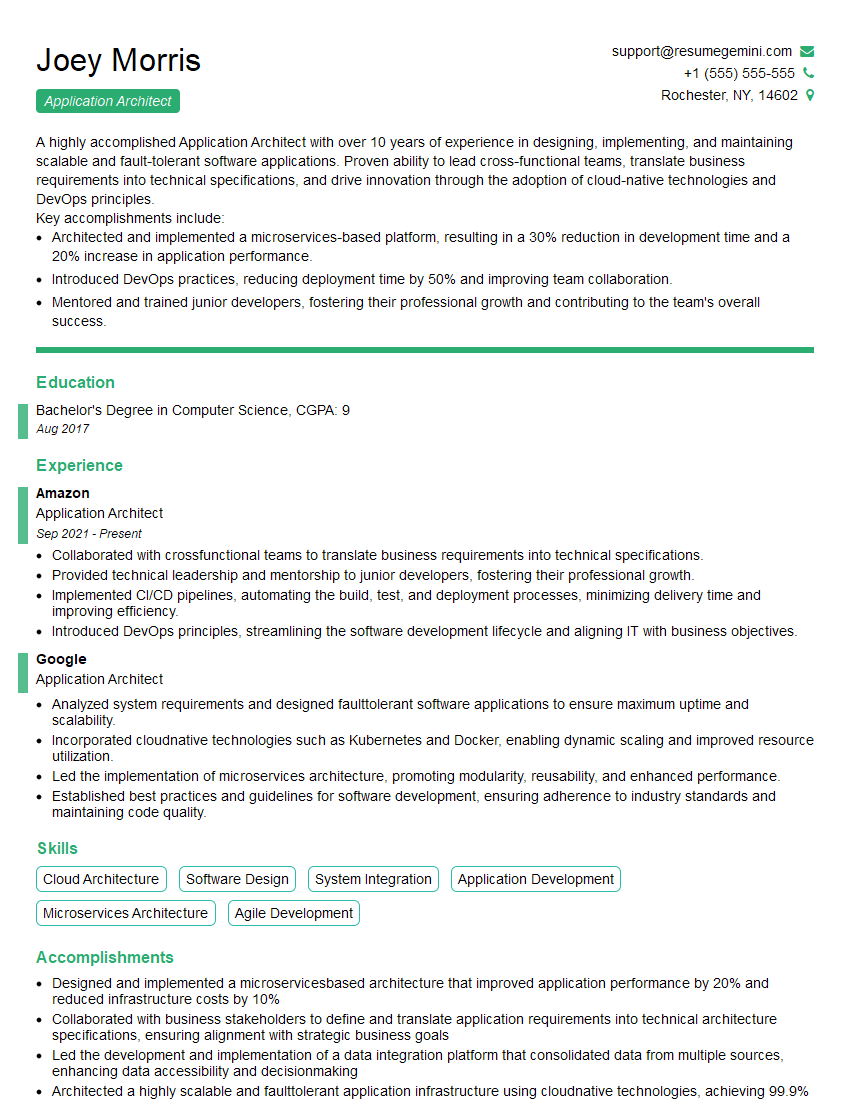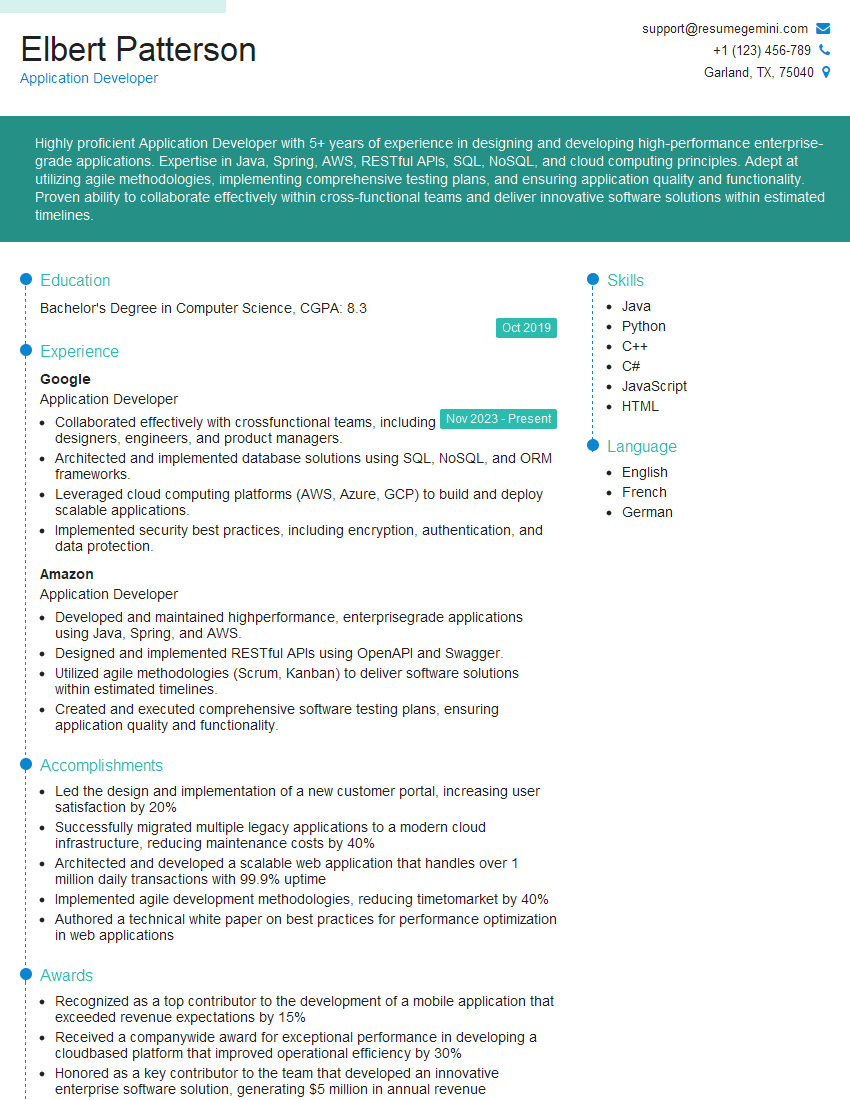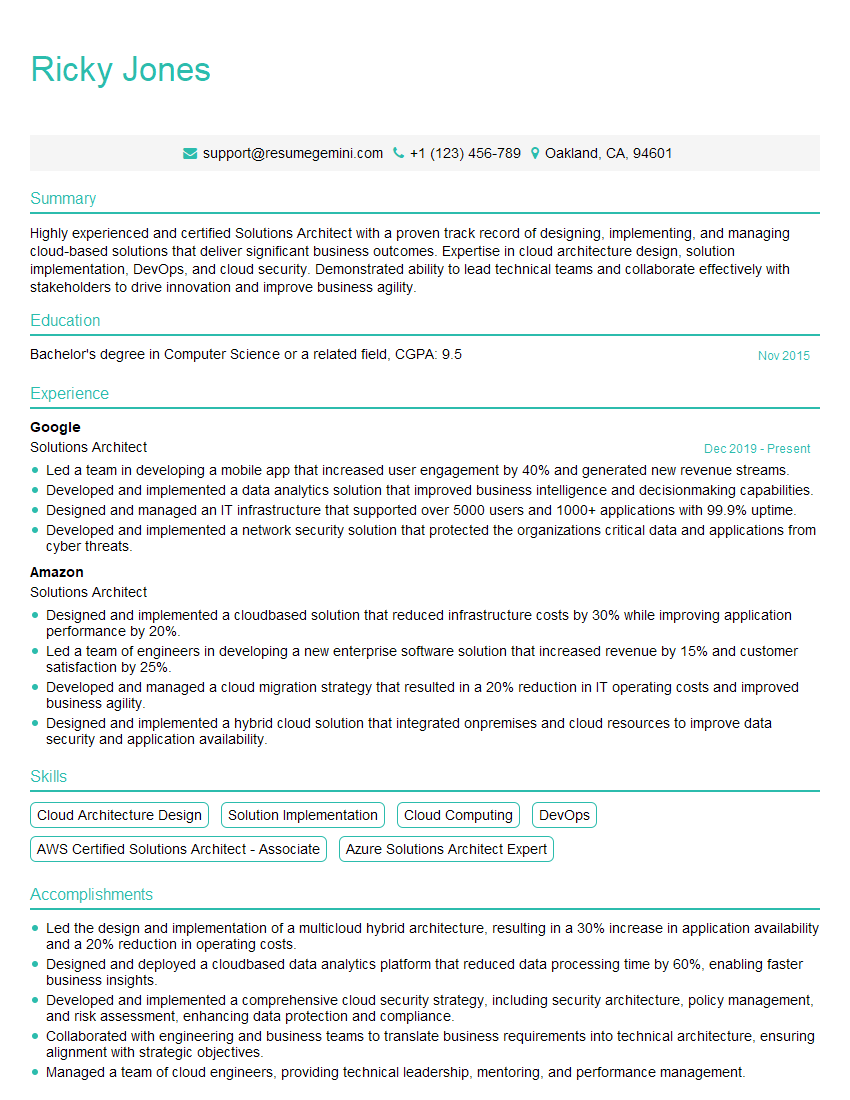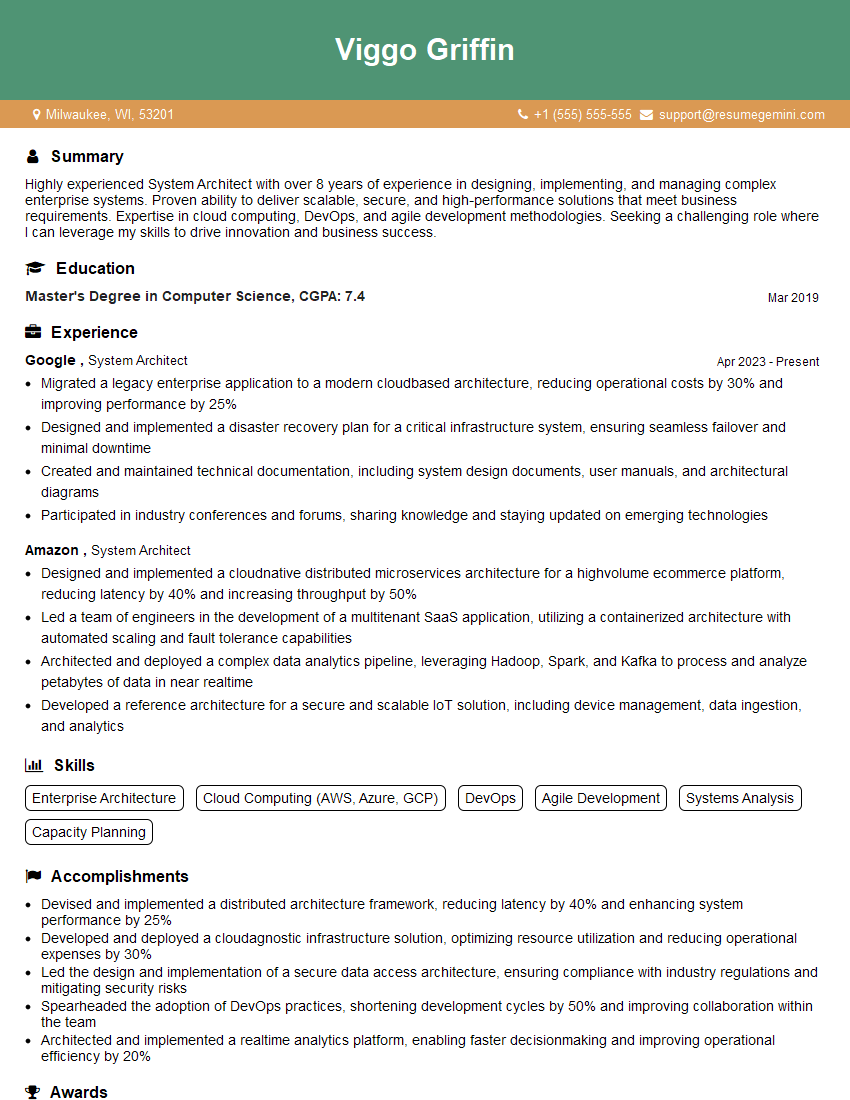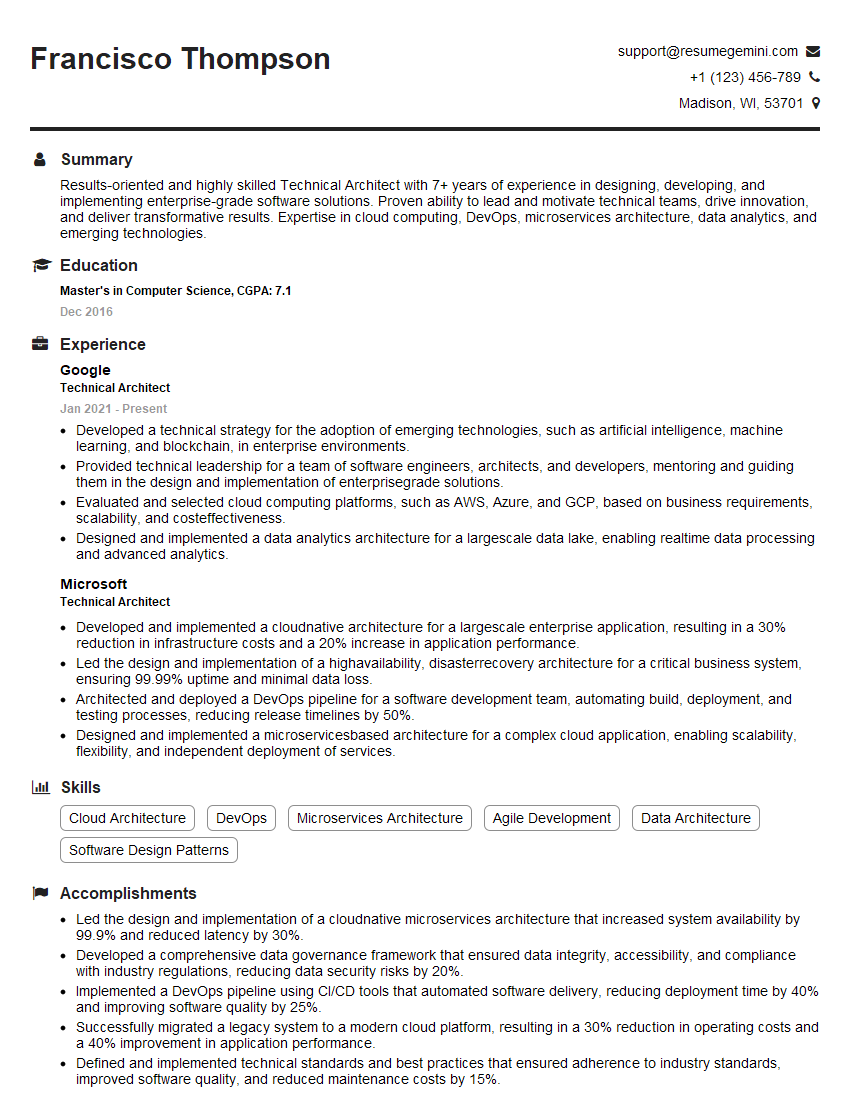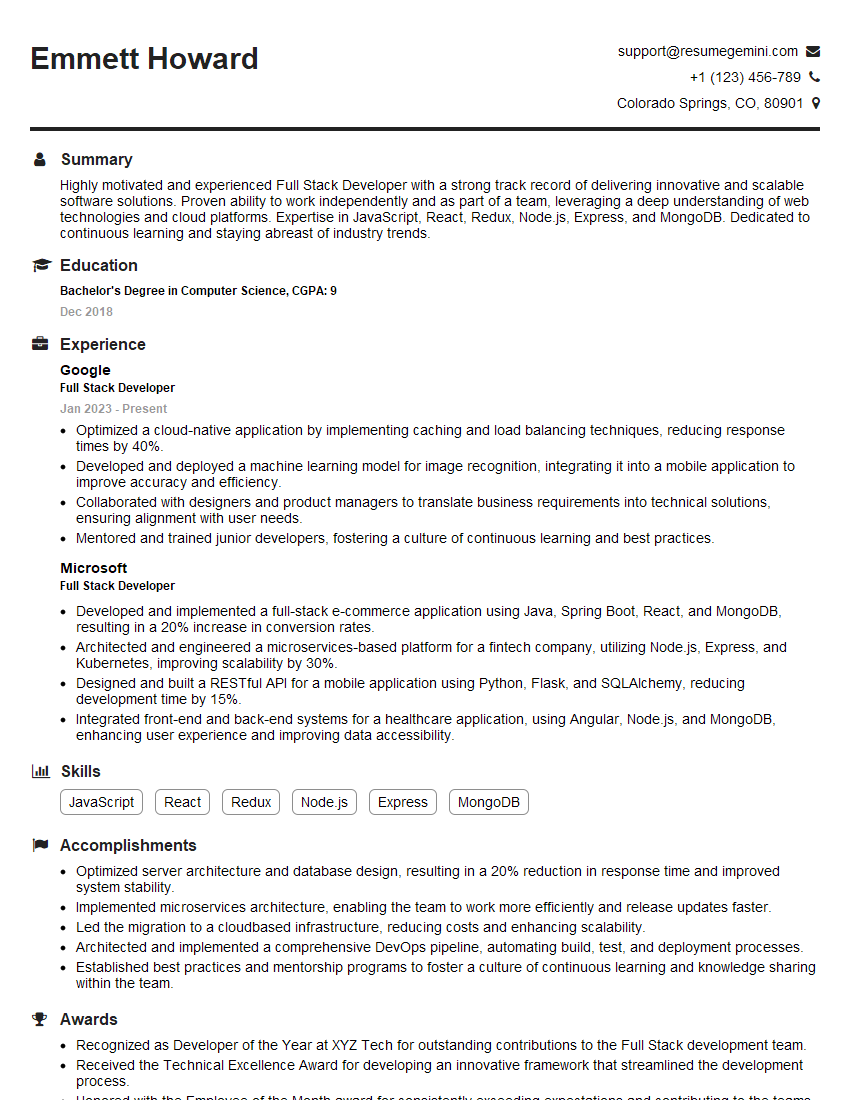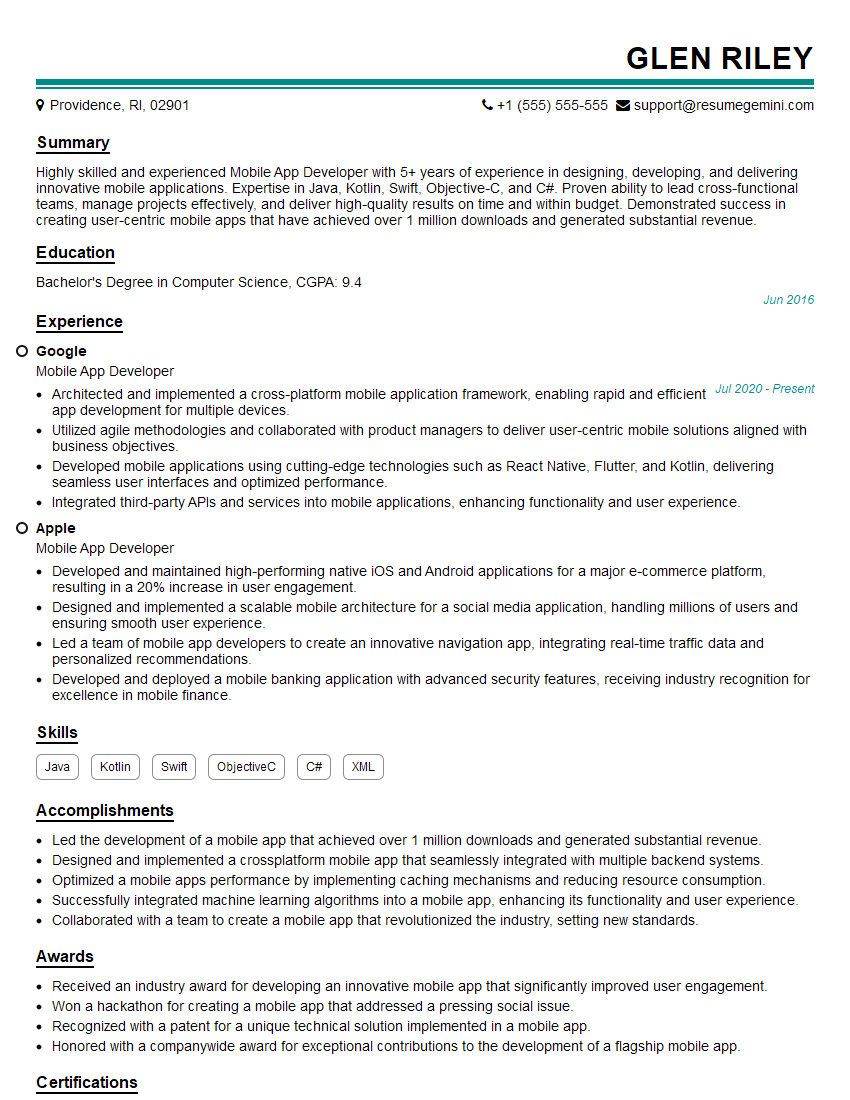The right preparation can turn an interview into an opportunity to showcase your expertise. This guide to Application Development Life Cycle (ADLC) interview questions is your ultimate resource, providing key insights and tips to help you ace your responses and stand out as a top candidate.
Questions Asked in Application Development Life Cycle (ADLC) Interview
Q 1. Explain the different phases of the Application Development Life Cycle (ADLC).
The Application Development Life Cycle (ADLC) is a structured process for building software applications. While specific phases and names may vary slightly depending on the methodology used (Waterfall, Agile, etc.), a typical ADLC generally includes these key phases:
- Planning: This initial stage involves defining project goals, scope, requirements gathering (using techniques like user stories and use cases), and creating a project plan with timelines and resource allocation. Think of it as laying the foundation of a house – you need a blueprint before you start building.
- Requirements Analysis: This phase meticulously analyzes the gathered requirements to ensure clarity, completeness, and feasibility. It often involves creating detailed specifications, diagrams (like UML diagrams), and prototypes to visually represent the system’s functionality.
- Design: Here, the system architecture, database design, user interface (UI) design, and other technical aspects are planned out. This is where the blueprints become detailed architectural plans, specifying materials and construction methods.
- Development: This is where the actual coding takes place. Developers write the code based on the design specifications, following coding standards and best practices. This is the actual construction phase of the house.
- Testing: Thorough testing is critical to identify and fix bugs and ensure the software meets the defined requirements. This involves different testing types like unit testing, integration testing, system testing, and user acceptance testing (UAT). This is analogous to inspecting the house during and after construction for any flaws.
- Deployment: Once the software passes testing, it’s deployed to the production environment, making it accessible to end-users. This is the grand opening of the house.
- Maintenance: After deployment, ongoing maintenance is necessary to fix bugs, add new features, and adapt to changing requirements. This is akin to regular maintenance and repairs of the house after moving in.
Q 2. What are the key differences between Agile and Waterfall methodologies?
Waterfall and Agile are two prominent ADLC methodologies, but they differ significantly in their approach:
- Waterfall: This is a sequential approach where each phase must be completed before the next one begins. It’s highly structured and rigid, with a comprehensive upfront planning phase. Changes in requirements are difficult and costly to implement. Imagine building a house according to a fixed plan – you can’t easily change the design mid-construction.
- Agile: This iterative and incremental approach emphasizes flexibility and collaboration. It works in short cycles called sprints, delivering functional software increments at the end of each sprint. Changes in requirements are welcomed and integrated throughout the development process. Think of building with Lego blocks – you can easily adapt and add new features as you go.
Here’s a table summarizing the key differences:
| Feature | Waterfall | Agile |
|---|---|---|
| Flexibility | Low | High |
| Requirement Changes | Difficult and Expensive | Easy and Incorporated |
| Team Collaboration | Less emphasis | High emphasis |
| Feedback | Late in the cycle | Continuous |
| Risk Management | Difficult to adapt to risks | Risks addressed iteratively |
Q 3. Describe your experience with iterative development.
I have extensive experience with iterative development, primarily using Agile methodologies like Scrum and Kanban. In a recent project developing a mobile banking application, we adopted a Scrum approach. We worked in two-week sprints, delivering working software increments at the end of each sprint. This allowed us to get early feedback from users, adapt to changing requirements, and mitigate risks early on. For example, in one sprint, we focused on building the login functionality. After demonstrating a working login screen, we received valuable feedback that led to changes in the UI design before proceeding to the next sprint, focusing on account viewing. This iterative process ensured the final product was more aligned with user needs and expectations than a purely sequential approach would have allowed.
Q 4. How do you handle changing requirements during the ADLC?
Handling changing requirements is a crucial aspect of successful software development. The best approach depends heavily on the chosen methodology. In Agile, changes are expected and accommodated through processes like sprint reviews and daily stand-up meetings. New requirements are prioritized, analyzed for impact, and integrated into the backlog, potentially influencing the upcoming sprint plans. In Waterfall, changes are more challenging, often requiring formal change requests, impact assessments, and potentially budget and timeline adjustments. Regardless of the methodology, good communication and a robust change management process are key. This includes clearly documenting changes, assessing their impact, getting approvals, and communicating the changes to the entire development team.
Q 5. What testing methodologies are you familiar with?
My experience encompasses a wide range of testing methodologies, including:
- Unit Testing: Testing individual components or modules of the code.
- Integration Testing: Testing the interaction between different modules.
- System Testing: Testing the entire system as a whole.
- User Acceptance Testing (UAT): Testing by end-users to ensure the system meets their needs.
- Regression Testing: Testing after making changes to ensure no new bugs are introduced.
- Performance Testing: Evaluating system performance under various loads.
- Security Testing: Identifying vulnerabilities and security risks.
I’m proficient in using various testing frameworks like JUnit (for Java), pytest (for Python), and Selenium for UI testing. I also have experience with automated testing, which significantly improves efficiency and reduces the risk of human error.
Q 6. Explain your experience with version control systems (e.g., Git).
I’m highly proficient with Git, utilizing it daily for version control in all my projects. I understand branching strategies (like Gitflow), merging, conflict resolution, and using pull requests for code review. I’ve used Git to manage both individual projects and large collaborative efforts. For instance, in a recent project involving a team of 10 developers, we used Git’s branching capabilities to work concurrently on different features while ensuring smooth integration and preventing conflicts. We leveraged pull requests for code reviews, which enhanced code quality and knowledge sharing within the team. I’m also familiar with using platforms like GitHub and GitLab for collaborative development and code hosting.
Q 7. How do you ensure code quality throughout the ADLC?
Ensuring code quality is an ongoing process, not just a final step. Several key practices contribute to this:
- Code Reviews: Regular code reviews by peers are essential for identifying bugs, improving code style, and sharing knowledge. We use pull requests in Git to facilitate code reviews.
- Static Code Analysis: Using tools like SonarQube or FindBugs to automatically detect potential issues in the code without running it.
- Unit Testing: Writing comprehensive unit tests to ensure individual components work correctly.
- Coding Standards and Best Practices: Adhering to consistent coding styles and best practices improves code readability and maintainability.
- Automated Testing: Automating various testing levels significantly improves efficiency and reduces human error.
- Continuous Integration/Continuous Delivery (CI/CD): Implementing CI/CD pipelines automates the build, testing, and deployment processes, enabling faster feedback cycles and quicker identification of issues.
By employing these methods, we build robust, reliable, and maintainable software, reducing technical debt and enhancing the overall development process.
Q 8. Describe your experience with code reviews.
Code reviews are an integral part of ensuring code quality, maintainability, and adherence to best practices. My experience encompasses both participating in and leading code reviews across various projects and teams. I utilize a structured approach, typically focusing on code style, functionality, security, and potential bugs.
In practice, this involves carefully examining the code, understanding the logic, and looking for areas of improvement. For example, I might identify potential performance bottlenecks, suggest more efficient algorithms, or point out inconsistencies in coding style. I actively use checklists to ensure comprehensive coverage during review. I also actively encourage junior developers by providing constructive feedback and guiding them towards better coding practices.
Furthermore, I’m proficient in using various tools to facilitate code reviews, such as Git’s built-in review features and specialized platforms like GitHub or GitLab. I firmly believe a collaborative review process not only improves code quality but also serves as a valuable learning opportunity for all involved. A recent example saw me identifying a potential security vulnerability in a payment processing module during a review, preventing a significant issue in production.
Q 9. What is your experience with bug tracking and management systems?
Throughout my career, I’ve extensively used bug tracking and management systems like Jira, Bugzilla, and Azure DevOps. My experience goes beyond simply logging bugs; I understand the importance of detailed descriptions, clear reproduction steps, and proper categorization for effective issue resolution. I am familiar with different workflows, including Scrum and Kanban, and how bug tracking integrates seamlessly with these methodologies.
Effective bug management is about more than just recording issues; it’s about tracking their lifecycle, from initial discovery to resolution and verification. This includes assigning priorities based on severity and impact, tracking progress, and ensuring proper communication among team members. In a previous project, we used Jira’s workflow to successfully manage over 100 bugs, prioritizing critical issues to minimize disruption and maintain a smooth development process. This involved creating custom workflows, defining statuses, and configuring transitions to ensure a clear and efficient tracking process. I am comfortable training team members on the use of these tools and best practices related to efficient bug reporting and resolution.
Q 10. How do you prioritize tasks in a software development project?
Task prioritization is crucial for effective project management and timely delivery. I employ a multi-faceted approach combining several prioritization techniques, tailored to the specific project context. My methodology typically incorporates elements of MoSCoW (Must have, Should have, Could have, Won’t have) analysis, assigning priority based on business value, risk, and dependencies.
For instance, I prioritize tasks based on their impact on project goals. ‘Must-have’ features get top priority, followed by ‘Should-have’ and so on. Additionally, I consider the technical dependencies between tasks, ensuring that prerequisites are completed before moving on to subsequent ones. I often use a Kanban board to visually manage the workflow and prioritize tasks based on urgency and importance. This allows for flexibility and adaptability as the project progresses. Finally, regular refinement sessions and stakeholder feedback help adapt the prioritization scheme accordingly, thus keeping the focus on value delivery.
Q 11. Describe your experience with project management tools (e.g., Jira, Asana).
My experience with project management tools like Jira and Asana is extensive. I’ve utilized them to manage diverse projects, from small agile sprints to larger, more complex waterfall-based undertakings. My proficiency extends beyond basic task management; I understand how to configure workflows, customize dashboards, and utilize reporting features for effective project monitoring and analysis.
In Jira, for example, I’m adept at creating and managing sprints, tracking progress against planned velocity, and utilizing various chart views to visualize project health. Similarly, in Asana, I utilize custom fields and automation to streamline processes and improve team collaboration. In a recent project, we leveraged Jira’s reporting capabilities to identify bottlenecks in our development process and implement strategies for improved efficiency. I’m confident in my ability to set up, customize, and train teams to effectively utilize these platforms.
Q 12. Explain your experience with different software development models (e.g., Spiral, V-model).
I have experience working with various software development models, including the Spiral model and the V-model. The Spiral model, with its iterative approach and emphasis on risk management, is well-suited for complex projects where requirements might evolve over time. The V-model, on the other hand, offers a more structured, linear approach, aligning testing activities with each phase of development. My choice of model depends heavily on project specifics, including project complexity, risk tolerance, and client involvement.
For instance, in a project with evolving requirements and significant uncertainty, the iterative nature of the Spiral model allowed for flexibility and adaptation. Conversely, in a project with well-defined requirements and strict regulatory compliance, the V-model provided a more structured and auditable development process. I find that understanding the strengths and weaknesses of different models enables me to select the most suitable approach for each project and tailor it to meet the specific needs and constraints.
Q 13. How do you manage risk in a software development project?
Risk management is paramount in software development. My approach is proactive, involving identifying potential risks early in the project lifecycle and developing mitigation strategies. This includes utilizing risk assessment techniques like SWOT analysis (Strengths, Weaknesses, Opportunities, Threats) and brainstorming sessions with the team. I typically document identified risks, their likelihood, and potential impact in a risk register.
Once risks are identified, I prioritize them based on their likelihood and potential impact. High-priority risks require immediate attention and the development of robust mitigation plans. These plans might involve contingency planning, resource allocation, or adopting specific technologies or techniques to reduce the risk. For example, in a recent project, we identified a potential risk related to third-party API dependencies. We mitigated this by implementing thorough testing and having a fallback mechanism in place. Regular risk reviews ensure that the mitigation strategies remain effective as the project progresses.
Q 14. What is your experience with deployment and release management?
My experience with deployment and release management encompasses various methodologies, including continuous integration/continuous delivery (CI/CD), and more traditional phased rollouts. I’m proficient in using various tools, such as Jenkins, GitLab CI, and Azure DevOps, to automate the deployment process. This automation reduces manual errors, accelerates deployment times, and improves overall efficiency.
A critical aspect of my approach is rigorous testing, including unit, integration, and system testing, before any release. I also employ strategies like canary deployments and A/B testing to minimize the impact of potential issues in production. Furthermore, I understand the importance of rollback plans to quickly revert to previous versions if any problems arise after deployment. A recent project saw us successfully implement a CI/CD pipeline, reducing deployment time from days to hours, and significantly improving our release frequency.
Q 15. How do you handle technical debt?
Technical debt, in software development, refers to the implied cost of rework caused by choosing an easy solution now instead of using a better approach that would take longer. Think of it like taking a shortcut – it saves time in the short term, but might require significant effort to fix later. I handle technical debt proactively through a multi-pronged approach.
Regular Audits: I advocate for regular code reviews and technical debt assessments. These help identify areas needing refactoring or improvement before they become major problems. Tools like SonarQube can automate this process significantly.
Prioritization: Not all technical debt is created equal. I prioritize addressing debt based on its impact on performance, security, maintainability, and future development. We use a system that scores debt based on these factors, allowing us to focus on the most critical issues first.
Strategic Planning: I incorporate time for refactoring and code cleanup into sprint plans. This ensures that we’re not constantly playing catch-up. Small, incremental improvements are far more manageable than one giant refactoring effort.
Documentation: Clear and concise documentation of the technical debt, including its origin, impact, and proposed solutions, is crucial. This ensures that everyone is aware of the debt and its implications.
Communication: Open communication with the team, stakeholders, and product owners is vital. Transparency about the existence and planned mitigation of technical debt fosters trust and better decision-making.
For example, in a past project, we identified a significant amount of debt in our database schema. Instead of a disruptive overhaul, we prioritized incremental improvements, refactoring specific sections during planned maintenance windows, ultimately resulting in a cleaner, more efficient database without major disruptions to ongoing development.
Career Expert Tips:
- Ace those interviews! Prepare effectively by reviewing the Top 50 Most Common Interview Questions on ResumeGemini.
- Navigate your job search with confidence! Explore a wide range of Career Tips on ResumeGemini. Learn about common challenges and recommendations to overcome them.
- Craft the perfect resume! Master the Art of Resume Writing with ResumeGemini’s guide. Showcase your unique qualifications and achievements effectively.
- Don’t miss out on holiday savings! Build your dream resume with ResumeGemini’s ATS optimized templates.
Q 16. What are your preferred tools for documenting software development processes?
Choosing the right tools for documenting software development processes is crucial for effective collaboration and maintainability. My preferred tools depend on the project’s size and complexity, but I generally favor a combination of:
Confluence: For comprehensive documentation, including requirements specifications, design documents, and user manuals. Its wiki-like structure enables easy collaboration and version control.
Jira: For tracking tasks, bugs, and progress. Its integration with other development tools simplifies project management and provides a central repository for issue tracking.
PlantUML: For creating clear and concise diagrams, such as UML diagrams, sequence diagrams, and network diagrams. These visual aids improve understanding of system architecture and processes.
Swagger/OpenAPI: For API documentation. This ensures that all stakeholders have a clear understanding of the API’s functionality and usage, streamlining integration efforts.
In addition to these tools, I always ensure that the code itself is well-documented using inline comments and docstrings, following a consistent style guide. This makes the code more readable and easier to understand for future maintenance and updates. A good example is using JSDoc for Javascript projects.
Q 17. Explain your experience with different types of databases.
My experience spans several database types, each with its own strengths and weaknesses. I’ve worked extensively with:
Relational Databases (RDBMS): Such as MySQL, PostgreSQL, and SQL Server. I’m proficient in writing SQL queries, designing relational schemas, and optimizing database performance. I’m familiar with concepts like normalization, indexing, and query optimization. For example, I once optimized a slow-performing query on a large MySQL database by adding appropriate indexes, reducing the query execution time by over 80%.
NoSQL Databases: Including MongoDB (document database) and Cassandra (wide-column store). I understand when to choose a NoSQL database over a relational database, typically for scenarios requiring high scalability, flexibility, and performance for specific workloads. For example, I used MongoDB to handle large volumes of unstructured data in a social media application, leveraging its flexibility to accommodate evolving data structures.
Graph Databases: I have experience with Neo4j, which is particularly useful for applications involving complex relationships between data entities. For example, using a graph database helped us significantly improve the efficiency of a recommendation engine by quickly traversing complex relationships between users and products.
My choice of database always depends on the specific requirements of the project, considering factors such as data structure, scalability needs, and performance expectations.
Q 18. Describe your experience with API integration.
API integration is a core part of modern application development. My experience encompasses various aspects of API integration, from designing APIs to consuming and integrating third-party APIs. I am proficient in using various protocols like REST and SOAP, and I understand the importance of proper authentication and authorization mechanisms such as OAuth 2.0 and JWT.
I’ve used tools like Postman for API testing and debugging, and I’m familiar with API gateways and orchestration tools. I understand the nuances of handling different data formats, including JSON and XML. For example, in a recent project, I integrated a payment gateway API into an e-commerce application using RESTful API calls and OAuth 2.0 for secure authentication. This involved handling various error conditions and ensuring secure transaction processing. Another example involves using message queues (like RabbitMQ or Kafka) for asynchronous API communication, which significantly improved the scalability and resilience of the application.
I emphasize building robust and well-documented APIs, ensuring they are easily maintainable and scalable. This includes using appropriate design patterns and following best practices for error handling and security.
Q 19. How do you ensure the security of your applications?
Application security is paramount. My approach involves a layered security strategy encompassing several key areas:
Secure Coding Practices: I follow secure coding guidelines, including input validation, output encoding, and preventing SQL injection and cross-site scripting (XSS) vulnerabilities. Regular code reviews and static code analysis help identify potential security flaws early in the development process.
Authentication and Authorization: I implement robust authentication and authorization mechanisms to control access to application resources. This includes using secure password hashing techniques, multi-factor authentication, and role-based access control.
Data Protection: I utilize encryption techniques to protect sensitive data both in transit and at rest. This includes using HTTPS for secure communication and database encryption for protecting data stored in databases.
Regular Security Audits and Penetration Testing: I advocate for regular security audits and penetration testing to identify and address potential vulnerabilities. These assessments help us proactively identify and mitigate threats before they can be exploited.
Compliance: I ensure applications adhere to relevant security standards and regulations, such as GDPR, CCPA, or HIPAA, depending on the project’s context.
For instance, in a previous project involving handling sensitive user data, we implemented end-to-end encryption, robust access controls, and regular security audits to ensure compliance with GDPR regulations.
Q 20. What is your experience with performance testing and optimization?
Performance testing and optimization are crucial for delivering high-quality applications. My experience includes various aspects of performance testing, from load testing and stress testing to identifying and resolving performance bottlenecks.
I’ve used tools like JMeter and Gatling for load testing, identifying the application’s capacity to handle concurrent users and potential performance bottlenecks under stress. Profiling tools, such as YourKit or VisualVM, are used to identify performance hotspots within the application code. Database performance optimization techniques, including indexing, query optimization, and database caching, are also part of my toolkit.
For example, in a previous project, we identified a performance bottleneck caused by inefficient database queries. By optimizing the queries and adding appropriate indexes, we significantly improved the application’s response time and scalability. This involved using database profiling tools to pinpoint slow queries, refactoring inefficient code, and carefully choosing the right indexes for the database schema.
My approach involves a systematic process of identifying performance bottlenecks, analyzing their root causes, and implementing targeted optimizations. Continuous monitoring and performance testing are integral parts of this process.
Q 21. Describe a time you had to debug a complex software issue.
One particularly challenging debugging experience involved a complex issue in a high-traffic e-commerce application. The application experienced intermittent failures, resulting in order processing delays and frustrated users. The error logs were not providing clear clues, making it difficult to pinpoint the root cause.
My approach involved:
Systematic Investigation: I started by gathering as much information as possible, including error logs, application metrics, and user reports. I prioritized the most frequently occurring error messages to focus my efforts.
Reproducing the Issue: The intermittent nature of the issue made it challenging to reproduce consistently. I worked closely with the QA team to develop a repeatable test case, which significantly helped isolate the problem.
Debugging Tools: I used debugging tools such as debuggers and profilers to trace the execution flow and identify areas of concern. This included setting breakpoints to analyze variables and stack traces to understand the call sequence.
Code Review: After identifying the potential source of the error, I performed a thorough code review, paying close attention to the relevant code sections. This helped confirm the problem and identify possible solutions.
Collaborative Problem-Solving: I collaborated with other developers and engineers to brainstorm solutions and share insights. This helped gain different perspectives and speed up the problem-solving process.
Ultimately, the issue was traced to a race condition in a multi-threaded section of the code. The solution involved implementing proper synchronization mechanisms to prevent concurrent access to shared resources. This resolved the intermittent failures and significantly improved the application’s stability and reliability. This experience reinforced the importance of robust testing, thorough error logging, and effective collaboration in tackling complex debugging challenges.
Q 22. How do you stay up-to-date with the latest technologies and trends in software development?
Staying current in the rapidly evolving world of software development requires a multi-pronged approach. I actively participate in several key strategies to ensure I remain at the forefront of technological advancements.
Online Courses and Platforms: I regularly engage with platforms like Coursera, edX, Udemy, and Pluralsight to access high-quality courses on emerging technologies and best practices. This allows me to delve deep into specific areas and obtain verifiable certifications. For example, I recently completed a course on serverless architecture on AWS.
Industry Blogs and Publications: I follow influential blogs and publications like InfoQ, Hacker News, and various technology-specific blogs (e.g., those focusing on React, Kubernetes, etc.) to stay updated on the latest news, articles, and insights from experts in the field. This helps me understand the broader trends shaping the industry.
Conferences and Workshops: Attending industry conferences and workshops (both in-person and online) provides invaluable opportunities to network with peers, learn from leading experts, and gain hands-on experience with new tools and techniques. For instance, I attended DevRelCon last year and gained valuable insights into community building and open-source contribution.
Open Source Contributions: Contributing to open-source projects is a fantastic way to learn from experienced developers, enhance my skills, and stay abreast of the latest advancements. I’ve contributed to several projects on GitHub, gaining practical experience with collaborative development and best practices.
Networking and Communities: Actively participating in online and offline developer communities (e.g., meetups, forums) allows me to share knowledge, learn from others, and stay informed about new trends and challenges. This is invaluable for understanding practical applications and real-world implementations.
Q 23. What is your approach to learning new programming languages or frameworks?
My approach to learning new programming languages or frameworks is methodical and highly practical. I believe in a blend of theoretical understanding and hands-on experience.
Structured Learning: I start with a well-structured learning path, often using online courses or tutorials specifically designed for beginners. This ensures I grasp fundamental concepts and syntax correctly from the outset. I find that creating small sample projects helps solidify understanding.
Hands-on Projects: I strongly believe in learning by doing. Once I have a foundational understanding, I immediately start working on small, personal projects that challenge me to apply the new language or framework. This could be anything from a simple web application to a small utility tool.
Real-World Application: Whenever possible, I try to integrate the new skill into existing projects or find opportunities to use it in a real-world context. This helps me understand its practical implications and limitations in a professional setting. For example, when learning React, I re-built a personal project using it to gain real-world experience.
Community Engagement: I engage with online communities and forums dedicated to the specific language or framework. This allows me to ask questions, learn from others’ experiences, and stay updated on best practices and potential pitfalls. Participating in these forums also fosters a sense of community and helps develop my problem-solving abilities in a supported environment.
Documentation and Examples: I meticulously read the official documentation and refer to code examples provided by the language or framework creators. This helps me understand the intended use cases, design patterns, and best practices.
Q 24. Describe your experience with working in an Agile team.
I have extensive experience working in Agile teams, primarily using Scrum and Kanban methodologies. I thrive in collaborative, iterative environments where continuous feedback and adaptation are paramount.
Sprint Participation: I actively participate in sprint planning, daily stand-ups, sprint reviews, and retrospectives. I contribute effectively to story estimation, task breakdown, and identifying potential roadblocks.
Collaboration and Communication: I’m a strong believer in open and transparent communication. I proactively share my progress, challenges, and insights with the team. I also actively listen to team members’ perspectives and contribute to a positive and supportive team environment. I regularly participate in code reviews and pair programming sessions.
Adaptability: Agile environments require adaptability. I’m comfortable with changing priorities and requirements. I approach changes as opportunities to learn and improve, and I actively contribute to finding efficient solutions.
Continuous Improvement: I actively participate in sprint retrospectives, focusing on identifying areas for improvement in our process and team dynamics. I believe that continuous learning and process optimization are critical to success in an Agile context.
Example: In a recent project using Scrum, I was able to identify a bottleneck in our CI/CD pipeline during a sprint review. By working with the DevOps team, we implemented a solution that improved our deployment speed significantly, reducing the time it took to release new features.
Q 25. How do you collaborate with designers and other stakeholders?
Collaboration with designers and stakeholders is crucial for successful software development. I approach it by fostering open communication and mutual understanding.
Regular Communication: I maintain regular communication with designers and stakeholders through various channels, including daily stand-ups, design reviews, and dedicated meetings. This ensures everyone stays informed and aligned.
Shared Understanding: I make a point of understanding the design rationale and user needs behind design decisions. I actively ask clarifying questions to ensure a clear understanding of the design intent. I also explain technical constraints and possibilities to designers to find optimal solutions.
Prototyping and Feedback: I believe in iterative development and frequent feedback loops. I work closely with designers to build prototypes and solicit feedback from stakeholders throughout the development process. This helps identify and address issues early on.
Documentation and Specifications: I meticulously document design specifications, technical requirements, and project progress. This helps maintain transparency and fosters a shared understanding among all stakeholders.
Empathy and Understanding: I strive to understand the perspective of each stakeholder. I recognize that different stakeholders have different needs and priorities. I maintain respectful communication and ensure that everyone feels heard and valued.
Q 26. Explain your experience with Continuous Integration and Continuous Delivery (CI/CD).
Continuous Integration and Continuous Delivery (CI/CD) are essential for modern software development. My experience includes designing, implementing, and maintaining CI/CD pipelines using various tools and technologies.
Pipeline Design and Implementation: I have experience designing and implementing CI/CD pipelines using tools like Jenkins, GitLab CI, and Azure DevOps. This includes setting up automated build, test, and deployment processes.
Testing and Quality Assurance: A robust CI/CD pipeline integrates automated testing at every stage. I’m proficient in various testing methodologies (unit, integration, system, end-to-end) and have experience implementing automated tests as part of the CI/CD process.
Infrastructure as Code (IaC): I have practical experience using IaC tools like Terraform and Ansible to manage and provision infrastructure for the CI/CD pipeline. This ensures consistency and repeatability across different environments.
Monitoring and Alerting: I’m adept at setting up monitoring and alerting systems to ensure that the CI/CD pipeline is running smoothly and to proactively identify and resolve potential issues. Tools like Prometheus and Grafana are familiar to me.
Example: In a previous role, I implemented a CI/CD pipeline using Jenkins that automated the entire build, test, and deployment process for a microservices-based application. This significantly reduced deployment time and improved the overall quality of our software releases.
Q 27. What is your experience with cloud computing platforms (e.g., AWS, Azure, GCP)?
I have significant experience with cloud computing platforms, primarily AWS and Azure. I’m comfortable designing, deploying, and managing applications in cloud environments.
AWS: I have worked extensively with AWS services, including EC2, S3, RDS, Lambda, and ECS. I understand the nuances of different services and can choose the most appropriate ones for specific use cases. I have experience configuring and managing security groups, IAM roles, and other security best practices.
Azure: My experience with Azure includes working with virtual machines, storage accounts, databases, and Azure Functions. I am familiar with Azure’s resource management and deployment models, including ARM templates.
Containerization and Orchestration: I’m proficient in using Docker and Kubernetes for containerizing and orchestrating applications in cloud environments. This allows for efficient scaling and management of applications.
Serverless Computing: I have experience designing and deploying serverless applications using AWS Lambda and Azure Functions. This allows for cost-effective and scalable solutions.
Cost Optimization: I understand the importance of cost optimization in cloud environments and have experience implementing strategies to minimize cloud spending without compromising performance or reliability.
Q 28. Describe a project where you had to overcome a significant technical challenge.
During a project involving the development of a high-traffic e-commerce platform, we encountered a significant performance bottleneck. The application was experiencing slow response times and frequent crashes under heavy load.
Problem Identification: Through rigorous performance testing and analysis, we identified the bottleneck as originating from inefficient database queries and a lack of proper caching mechanisms.
Solution Development: To address the problem, we implemented several key strategies. This included optimizing database queries, using connection pooling to improve database connectivity, and implementing Redis caching to reduce database load. We also implemented load balancing and auto-scaling to distribute traffic more efficiently.
Implementation and Testing: We implemented these changes iteratively, testing and monitoring the performance at each step. This approach allowed us to identify and address any new issues that might have arisen.
Result: After implementing these optimizations, we observed a significant improvement in response times and overall system stability. The application could handle significantly higher traffic loads without experiencing performance issues.
Learnings: This experience reinforced the importance of proactive performance testing and optimization from the initial stages of development. It also highlighted the effectiveness of a data-driven approach to problem-solving, where careful analysis and monitoring guide the implementation of solutions.
Key Topics to Learn for Application Development Life Cycle (ADLC) Interview
- Requirements Gathering and Analysis: Understanding how to elicit, analyze, and document user needs and translate them into technical specifications. Consider practical exercises in defining scope and creating user stories.
- Design and Architecture: Exploring different architectural patterns (e.g., microservices, monolithic) and their trade-offs. Practice designing a system for a specific scenario, focusing on scalability and maintainability.
- Development and Coding: Focusing on best practices like code reviews, version control (Git), and testing methodologies (unit, integration, system). Consider how to demonstrate your proficiency in a specific programming language or framework.
- Testing and Quality Assurance (QA): Understanding different testing levels (unit, integration, system, user acceptance testing) and their importance. Explore common testing frameworks and methodologies.
- Deployment and Release Management: Familiarizing yourself with different deployment strategies (e.g., continuous integration/continuous deployment – CI/CD) and the importance of monitoring and logging. Think about how you’d handle a production incident.
- Maintenance and Support: Understanding the ongoing processes involved in maintaining and supporting a deployed application, including bug fixing, performance tuning, and security updates. Consider real-world scenarios and how you’d address them.
- Agile Methodologies: Understanding Agile principles (e.g., Scrum, Kanban) and their application in the ADLC. Prepare to discuss your experience with Agile frameworks and how you contribute to a team’s success.
- Project Management Fundamentals: While not strictly coding, understanding basic project management concepts like timelines, budgeting, and risk management is crucial for demonstrating a holistic understanding of the ADLC.
Next Steps
Mastering the Application Development Life Cycle (ADLC) is crucial for career advancement in software development. A strong understanding of each phase demonstrates a holistic view of software creation and positions you as a valuable asset to any team. To maximize your job prospects, create a strong, ATS-friendly resume that highlights your ADLC expertise. ResumeGemini is a trusted resource to help you build a professional resume that showcases your skills and experience effectively. Examples of resumes tailored to Application Development Life Cycle (ADLC) roles are available to help you craft a winning application.
Explore more articles
Users Rating of Our Blogs
Share Your Experience
We value your feedback! Please rate our content and share your thoughts (optional).
What Readers Say About Our Blog
This was kind of a unique content I found around the specialized skills. Very helpful questions and good detailed answers.
Very Helpful blog, thank you Interviewgemini team.





